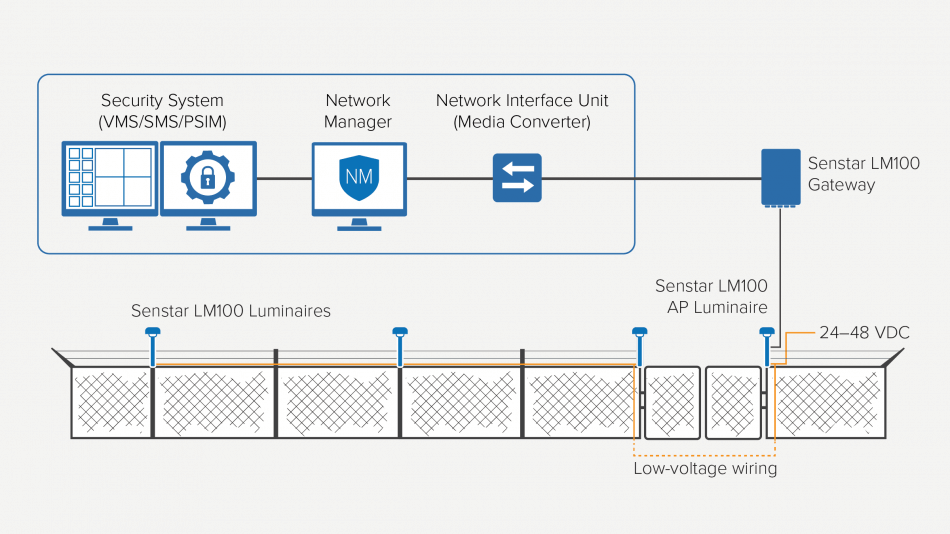![]()
Intrusion Detection
- Built-in accelerometer detects attempts to cut, climb or lift the fence fabric
- Reports intrusion attempt location to the site’s security system
- Can activate other deterrent systems like intercoms or other security lights
Perimeter Intrusion Detection and Deterrence System
Combining two key security functions in one cutting-edge product, the Senstar LM100 acts as a powerful deterrent against intruders, detecting and illuminating them at the fence line while alerting the site’s security system.
![]()
![]()
![]()
Optimized for use with surveillance camera systems, the Senstar LM100 provides localized, uniform, configurable lighting along the fence line. Uniform coverage lets cameras operate with a higher dynamic range, ensuring objects and people are illuminated while avoiding the generation of dark silhouettes in front of bright backgrounds. Each LM100 luminaire also includes built-in accelerometer technology to detect any attempt to cut, climb or lift the fence fabric. Luminaires communicate with each other over a wireless self-healing mesh network to relay information to the local security system (such as sirens and cameras) and/or to a networked SMS.

Each Senstar LM100 luminaire includes a built-in accelerometer to detect attempts to cut, climb or lift the fence fabric. When networked, the LM100 reports intrusion attempt locations to the site’s security system to enable a directed response. Early detection at the perimeter means the LM100 can provide instant, visible deterrence by enabling or strobing its lighting within the immediate area, trigger warnings and alarms, as well as cue up camera systems – all while the intruder remains outside the building or protected area.
When compared to traditional security lighting technologies, the Senstar LM100 can reduce electrical consumption costs by as much as 95%. In addition, the LEDs used in the luminaires have a 50,000 hour minimum life expectancy and are designed for outdoor use in all environments.
Targeted illumination along the fence line and warm-light option minimizes light pollution, enabling the Senstar LM100 to be used near light-sensitive areas, including airports, residential housing, and nature preserves. International Dark-Sky Association (IDA) approved, the Senstar LM100 is an ideal choice in regions that mandate reductions in light glare, trespassing, and pollution from outdoor fixtures.
With programmable I/O ports and support for Ethernet, RS-422 and fiber optic communication cards, the Senstar LM100 can work with virtually any security system.
The Senstar LM100 is easy to install. The luminaires use worm gear clamps to attach to existing fence posts while built-in mounting flanges enable installation on walls and other structures. The luminaires can be installed at different heights so as to not interfere with existing outrigging on the fence. Inter-luminaire communication is handled via an encrypted self-healing mesh network, eliminating the need to run communications wiring along the fence line.
Senstar’s Wireless Gate Sensor or UltraWave microwave sensor can be used with the Senstar LM100 system to protect swinging or sliding gates.
The Senstar LM100 uses the same configuration and integration software as other Senstar products, reducing training requirements while increasing operational efficiencies. The device is configured and calibrated with easy-to-use Windows®-based software over a USB or network connection. Alarms, control, and status information is managed by the Network Manager software, which provides a common unified interface for Senstar’s video and security management software as well as other industry-leading third-party systems.
The Senstar LM100 typically communicates with the security system via an Ethernet, RS-422 or fiber optic interface. The communications network may be shared with other Senstar sensors to reduce infrastructure requirements. Integrations using the LM100’s programmable I/O ports are also supported.

Return to Category
View All Documents
Installation and Configuration
View General Info
For physical security professionals, ensuring that a site’s security program (physical systems, people and procedures) achieves its goal of reducing risk and protecting assets is of primary importance. Traditionally, this means...
A recent article posted on securitymagazine.com summarized six challenges associated with securing the perimeters of large facilities. In our last post, we looked at the first three challenges. In Part 2...
A recent article posted on securitymagazine.com summarized six challenges associated with securing the perimeters of large facilities. In Part 1 of this article, we examine the first three challenges in greater...